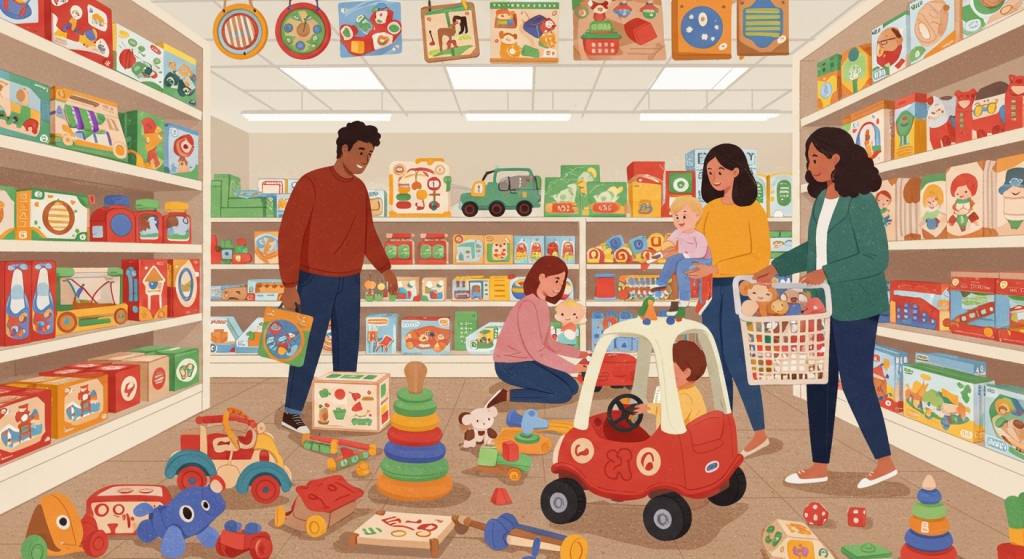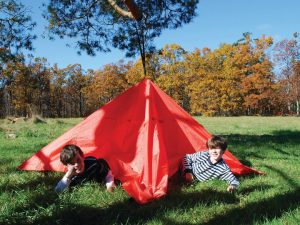Toddlers are naturally curious explorers, eager to learn about the world around them. They want to touch, feel, taste, and experiment with everything in sight. If you’re a parent or caregiver, you’ve likely seen this boundless curiosity firsthand. It can be exciting—yet overwhelming—to figure out how best to nurture these inquisitive minds. That’s where educational toys for toddlers can shine. By choosing the right learning tools, you can encourage their cognitive development, spark creativity, and instill a lifelong love of discovery. In this guide, we’ll walk you through why these toys matter, which categories to consider, and how to maximize their benefits at home.
What We'll Cover
- Why Are Educational Toddler Toys Important?
- Key Factors to Consider When Choosing Learning Toys for Toddlers
- Popular Categories of Educational Toys for Toddlers
- 1. Building Blocks
- 2. Shape Sorters & Puzzles
- 3. Musical Instruments
- 4. Pretend Play Sets
- 5. Interactive Electronics
- 5 Best Educational Toddler Toys on Amazon
- LeapFrog Learning Friends 100 Words Book
- Melissa & Doug Jumbo Knob Wooden Puzzles
- Mega Bloks First Builders
- Fisher-Price Laugh & Learn Smart Stages Piggy Bank
- VTech Touch and Learn Activity Desk
- People Also Asked
- Do Toddlers Really Need Educational Toys?
- How Many Toys Should a Toddler Have?
- Are Electronic Toys Better Than Traditional Ones?
- Tips for Maximizing the Benefits of Educational Toys
- Conclusion
Why Are Educational Toddler Toys Important?

1. Foster Cognitive Development
Toddlers, typically ages 1–3, undergo rapid brain development. According to the Centers for Disease Control and Prevention (CDC), strong early experiences have a lasting impact on a child’s thinking, learning, and problem-solving skills. Educational toys for toddlers—like shape sorters and basic puzzles—promote problem-solving and critical-thinking abilities.
2. Enhance Motor Skills
From stacking blocks to coloring with crayons, every small movement matters. Toys that involve grasping, pulling, or manipulating pieces help develop both fine and gross motor skills. This foundation prepares children for later activities, such as writing or participating in sports.
3. Boost Language & Communication
Many learning toys incorporate letters, words, or sounds. Even something as simple as pointing out shapes or colors can spark meaningful conversations. Repetition of language-based games strengthens vocabulary, helping toddlers communicate more effectively.
4. Encourage Social & Emotional Growth
Through pretend play or interactive games, children learn how to share, take turns, and respect others’ space. These social-emotional skills are crucial for healthy relationships later in life. The American Academy of Pediatrics notes that toys enabling cooperative play can improve empathy and emotional intelligence.
Key Factors to Consider When Choosing Learning Toys for Toddlers

Selecting the best educational toys for toddlers can feel daunting. To simplify your decision-making, keep these criteria in mind:
-
Age Appropriateness
- Safety: Check for small parts and choking hazards.
- Skill Level: Choose toys that aren’t too easy—or too challenging. Aim for a slight stretch in ability to keep them engaged.
-
Developmental Milestones
- Physical: Are they developing fine or gross motor skills?
- Cognitive: Will this toy expand their thinking and reasoning?
- Language: Does the toy encourage naming objects, counting, or singing?
-
Versatility & Creativity
- Open-Ended Play: Toys that can be used in multiple ways (e.g., building blocks) often hold a child’s interest longer.
- Problem-Solving: Seek out toys that allow toddlers to experiment and find their own solutions.
-
Durability & Value
- Longevity: Opt for items that can grow with your toddler’s skills.
- Cost per Play Session Formula: When you're buying a toy, it's helpful to think about its value over time.
Popular Categories of Educational Toys for Toddlers

Below is a table summarizing some of the most beneficial categories of learning toys, along with recommended age ranges and key developmental benefits.
| Toy Category | Recommended Age | Developmental Benefits | Example |
|---|---|---|---|
| Building Blocks | 1–3 years | Fine motor, creativity, problem-solving | Large wooden block sets |
| Shape Sorters & Puzzles | 1–3 years | Spatial awareness, hand-eye coordination | Wooden shape puzzle boards |
| Musical Instruments | 1–3 years | Auditory stimulation, language, rhythm | Child-friendly drum or xylophone |
| Pretend Play Sets | 2–3 years | Imagination, social skills, language | Toy kitchen, doctor kit |
| Interactive Electronics | 2–3 years | Early tech literacy, cognitive skills | Talking alphabet tablets |
1. Building Blocks
Blocks are a classic example of educational toys for toddlers. They improve fine motor skills, teach balance and coordination, and allow your child to explore shapes and structures. Over time, toddlers learn basic physics concepts (like gravity!) when their towers topple.
2. Shape Sorters & Puzzles
Shape sorters help toddlers understand object permanence and spatial relationships. Wooden puzzles with large knobs or handles offer an easy grip, improving hand-eye coordination. These toys also encourage problem-solving as children figure out which piece fits where.
3. Musical Instruments
Child-sized instruments introduce toddlers to the concept of rhythm and cause-and-effect. Striking a drum or tapping a xylophone produces a direct, pleasing sound, which can boost auditory awareness. Singing along with musical toys also supports language development.
4. Pretend Play Sets
Kids love mimicking adult behaviors, and pretend play sets—like a toy kitchen or a miniature doctor’s kit—are perfect for role-playing. This imaginative play fosters social and emotional development, as toddlers practice teamwork and empathy when playing with others.
5. Interactive Electronics
While traditional toys often top the list for open-ended play, some well-designed electronic toys also serve as valuable learning tools. Alphabet tablets or interactive robots can teach letters, numbers, and basic coding concepts in an engaging way. However, balance is key: The American Academy of Pediatrics recommends moderating screen and electronic toy time, especially for young children.
5 Best Educational Toddler Toys on Amazon
Below are five well-loved toys that combine fun and learning. They each target multiple developmental areas, from motor skills to language acquisition.
LeapFrog Learning Friends 100 Words Book

Meet learning friends Turtle, Tiger and Monkey who will introduce more than 100 age-appropriate words chosen by learning experts
Word categories include: pets, animals, food, mealtime, colors, acti...
Why It’s Great: This interactive book introduces children to everyday words in both English and Spanish. Touching the pictures produces sounds and phrases, boosting vocabulary and listening skills.
Recommended Age: 18+ months
Melissa & Doug Jumbo Knob Wooden Puzzles

Extra-thick wooden puzzle features jumbo wooden pegs for easy grasping
Bright colors and sweet illustrations of familiar objects
Full-color, matching pictures underneath each piece
A perfect activi...
Why It’s Great: Designed with large wooden knobs for an easy grip, these puzzles help refine fine motor skills and teach shape recognition. The colorful images under each puzzle piece also spark curiosity about animals, shapes, and objects.
Recommended Age: 12+ months
Mega Bloks First Builders

The #1 Junior Construction Toy in the U.S.A. Features 80 blocks in 10 shapes and 9 vibrant colors
Build Them Up Big Building Bag is designed for little hands and growing minds
Creative Learning Pla...
Why It’s Great: These oversized building blocks are perfect for little hands. Toddlers can stack and connect blocks to create imaginative structures, practicing hand-eye coordination and problem-solving as they play.
Recommended Age: 12+ months
Fisher-Price Laugh & Learn Smart Stages Piggy Bank

Interactive toy piggy bank with 40+ songs, sounds and learning phrases
2 Smart Stages levels teach numbers and counting, colors, and Spanish words
Drop the coins into piggy’s back or press the nose...
Why It’s Great: This toy teaches counting, colors, and animal sounds. As toddlers drop coins into the piggy bank, they develop fine motor skills while also learning basic math concepts like counting to 10.
Recommended Age: 6+ months (up to 3 years)
VTech Touch and Learn Activity Desk

Interactive Learning: This toddler desk and chair set comes with 5 different activity pages to explore; your little one can engage with these directly on the desk to learn new words & sounds
Langua...
Why It’s Great: Featuring interactive pages, a working LED display, and a variety of activity cards, this toy introduces letters, numbers, and simple words. It quickly transforms into a child-sized desk, allowing your toddler to draw and create art on the flat surface.
Recommended Age: 2–5 years
People Also Asked

Do Toddlers Really Need Educational Toys?
Children are natural learners, and even simple household items can be educational when used creatively. However, specialized learning toys for toddlers can provide a structured pathway to practice important skills. They combine fun and learning in a way that captures a young child’s attention more consistently than everyday objects might.
How Many Toys Should a Toddler Have?
There’s no magic number, but research suggests that fewer, high-quality toys can encourage deeper, more sustained play. Too many options can overwhelm a toddler, leading to short, unfocused engagement with each item. Rotating toys—keeping some stored away and switching them out every few weeks—keeps interest fresh.
Are Electronic Toys Better Than Traditional Ones?
Not necessarily. Electronic toys can be educational if they focus on interactive learning rather than passive entertainment. Traditional toys often allow more open-ended play, which is critical for creativity. A balanced mix of both types helps children build a wide range of skills.
Tips for Maximizing the Benefits of Educational Toys

-
Play Together
Toddlers learn best when actively engaged with adults or peers. Ask questions and create mini-challenges. For example, if you’re stacking blocks, ask “Can we build a tower taller than your teddy bear?” This not only teaches height comparison but also encourages language use. -
Rotate & Update
Introduce new learning toys for toddlers gradually, and store some away for later. Bringing out a previously “forgotten” toy can feel brand-new and rekindle excitement. -
Model Curiosity
Children often mirror adult behavior. If they see you exploring or playing with a toy, they’re more likely to dive in themselves. Share your observations—like pointing out colors or shapes—and encourage your toddler to do the same. -
Encourage Self-Directed Play
While structured play has benefits, toddlers also need free exploration time. Let them guide the activity, even if it doesn’t follow the “right” steps. This freedom fosters confidence and creativity.
Conclusion
Educational toys for toddlers are more than just fun distractions; they’re powerful tools that guide young minds toward vital developmental milestones. From building blocks that inspire creativity to shape sorters that refine motor skills, well-chosen toys set the stage for long-term cognitive, social, and emotional growth. By focusing on age appropriateness, developmental milestones, and open-ended possibilities, you can create a rich learning environment right at home.
Remember to rotate toys, play alongside your child, and encourage their natural curiosity. Whether you’re exploring musical instruments, pretend play sets, or interactive electronics, the goal is to keep learning both engaging and meaningful. With the right approach, you’ll nurture a curious, confident toddler who’s ready to take on the next big adventure in early childhood—and beyond.
The responses below are not provided, commissioned, reviewed, approved, or otherwise endorsed by any financial entity or advertiser. It is not the advertiser’s responsibility to ensure all posts and/or questions are answered.





![Best Remote Control Cars For Kids [2022 Review]](/assets/images/80b330010aa907b77b0ed672f3a76cc8.png)